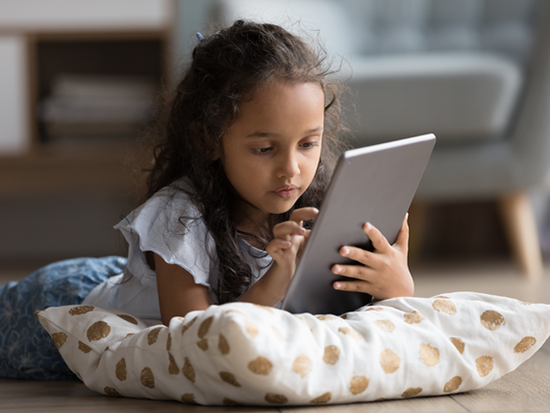 Reducing screen time, increasing physical activities and creating non-screen-related hobbies can help protect children’s eyes from irritation and strain.In today’s digital age, children’s eyes are seemingly glued to iPads, tablets and other digital devices. Although this may be the new “normal,” eye care providers at the University of Alabama at Birmingham worry about the long-term effects on children’s eyes.
Reducing screen time, increasing physical activities and creating non-screen-related hobbies can help protect children’s eyes from irritation and strain.In today’s digital age, children’s eyes are seemingly glued to iPads, tablets and other digital devices. Although this may be the new “normal,” eye care providers at the University of Alabama at Birmingham worry about the long-term effects on children’s eyes.
“The more time children spend on devices, the less time they spend outdoors, and spending time outdoors could slow down the progression of nearsightedness, which is becoming more prevalent in children,” said Marcela Frazier, O.D., pediatric optometrist at UAB Callahan Eye and associate professor in the UAB Department of Ophthalmology and Visual Sciences.
Prolonged exposure to screens can cause eye fatigue, eye irritation and headaches due to the increased demand on the visual system and the tendency to not blink while using them. To help combat these effects, Frazier provides tips to protect children’s overall eye health.
Set a screen time limit on devices
“During the pandemic, screen time increased for many children and has remained high,” Frazier said. “Excessive amounts of screen time can have many long-term effects on your children’s eyes.”
Limiting screen time can be challenging, but it is necessary to protect children’s eyes. Frazier recommends using parental codes on children’s devices to set a healthy limit to screen time.
The American Academy of Pediatrics and World Health Organization recommend these acceptable amounts of screen time:
- None for children under 2 years of age
- One hour per day for children 2 to 12 years old
- Two hours per day for teens and adults
For 24/7 emergency eye care needs or to make an appointment today, call UAB Callahan Eye at 844-UAB-EYES.
Balance screen time with physical activities
Create a schedule that balances screen time with physical activities, ensuring children have dedicated time to explore and engage in play.
Frazier suggests a few strategies to promote physical activity and outdoor play:
- Plan family outings that promote physical activity, such as trips to the park, hiking trails or enjoying nearby beaches.
- Organize playdates to allow for socialization, fun and physical activity.
- Join community programs such as clubs or sports team that provide another outlet for children to get their bodies moving.
- Embrace seasonal activities, like flying kites in the spring, swimming in the summer, jumping in leaves in autumn or building snow forts in winter.
 Encourage non-screen-related hobbies
Encourage non-screen-related hobbies
While physical activity and play can help reduce screen time and promote moving one’s body, there are other non-screen-related hobbies that provide stimulation and engagement.
“Reading is a great way to help children’s brains develop while preventing strain from screens and devices,” Frazier said. “It is also an activity that children can engage with in almost every environment.”
Other activity suggestions include painting, drawing, singing, playing an instrument, and building a puzzle with family and friends.
Signs of eye issues
Frazier says adults usually report symptoms like eyestrain, dryness, headaches and eye irritation after prolonged use of near devices; however, children may experience these issues and not be able to communicate them accurately. Parents may notice some signs of eye irritation and fatigue related to screen time in children manifested as excessive blinking, squinting, watery eyes, red eyes and some eye-rubbing.
If a child experiences prolonged signs of eye irritation, Frazier suggests making an appointment for a pediatric eye exam. With 24/7 emergency eye care needs or to make an appointment today, parents can call UAB Callahan Eye at 844-UAB-EYES.